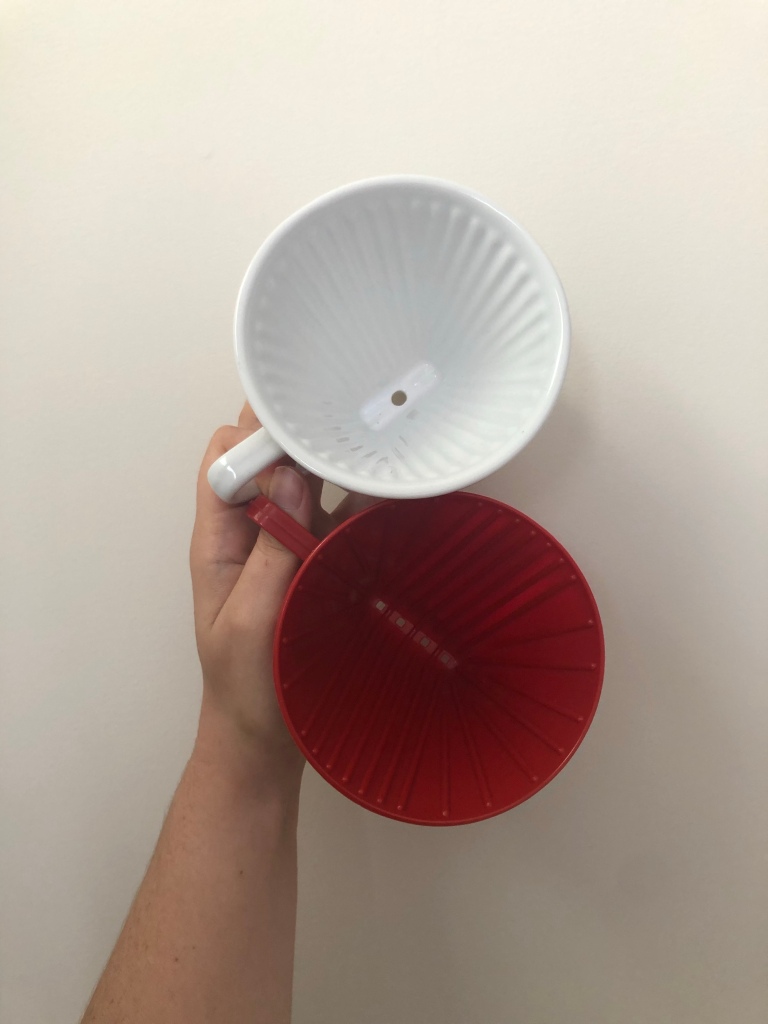
It’s been a while since one of my crazy coffee experiments, so why not start with holes. Five of them in total. You know, pour over cone holes. What did you think I meant?
Last month, I went to one of the biggest thrift stores that I’ve ever been to in Maryland because I saw it on TikTok. More rows of clothes than I knew what to do with, shelves of books, and stacks of kitchenware that left me looking for a couple hours. I would have kept going but the whole store was a bit overwhelming. Even though I haven’t posted one of these in awhile, I am constantly looking for new brewers and methods of making coffee especially in thrift and antique stores. I still hope to be one of those lucky few who find a Chemex in the vase section of the home goods sections.
For two dollars, I found this HIC red plastic pour over cone. I already had this white one, and am not usually one to buy something I already own but this red one was the exact same shape as my white one but with four holes at the bottom instead of one.
It got me thinking about the effects of holes in extraction. V60s, Chemexs, and some pour over cones feature only one hole, Bee House Drippers feature two, and Kalitas feature three (but is a flat-bottomed brewer as opposed to the other ones). But four? And in a cone shape?
Alright, let’s talk about the experiment:
For both brews, I did 20g of the Smalltime Blend from Reforma Roasters in Portland, Oregon with 320g of 205 degree water ground at 17 on a Baratza Encore. I also used a 30s bloom of 50g, then poured to 120g, 220g, and finally to 320g. The red cone finished dripping at 3 minutes, while the white one finished at 3:20, so not a huge time gap between the two. But, what did it taste like?
The coffee I used is a very bright, fruit forward coffee so it was a complex cup with notes of round citrus and dark berries at the same time. It almost tasted like fruit loops to me.
The Four-Hole cup was darker and a touch over-extracted. Much like a Kalita, next time I brew with it I will try it a setting or two coarser to balance out. The body and depth of this cup, however, was really nice and developed. A long-standing critique that I have had about the Kalita is that there is an acidic, grapefruit-life taste in every cup I brew unless it is a very dark roast. I tasted that same taste in this cup which makes me wonder how multiple channels for the coffee to come through can create a taste across brewers and different coffees. (You can read more about that taste I detected in the Brew Method Testing: Kalita Wave w/ Recipe from George Howell article I posted last year.)
Meanwhile, the one-hole cup while less layered than the other had a marked sweetness compared to four-holes. I got all the fruit notes from the coffee and like the other cup, but this was different. Like instead of just orange or berry, I got strawberry hard candy and gummy bear like fruit notes. If I were to pick a cup between the two, it would have been this one.
So, what does this mean?
The people that make the Java Presse has this to say about drainage holes, “These smaller, flow-restricting, holes produce coffee just as tasty as larger ones but are far more forgiving toward pouring motion and technique, and more user-friendly.”
If holes in brewers control the flow rate, then of course that makes sense that more holes or bigger holes would produce a faster brew. But the complexity? The sweetness? Perhaps, if I had fancy equipment, I could test the extraction of each brew but I also wondered if the coffee at the bottom of the one-holes brewer doesn’t get as saturated in parts where the four-hole brewer does.
All this to say, what do you think about brewer holes and extraction? How would you do this experiment differently?